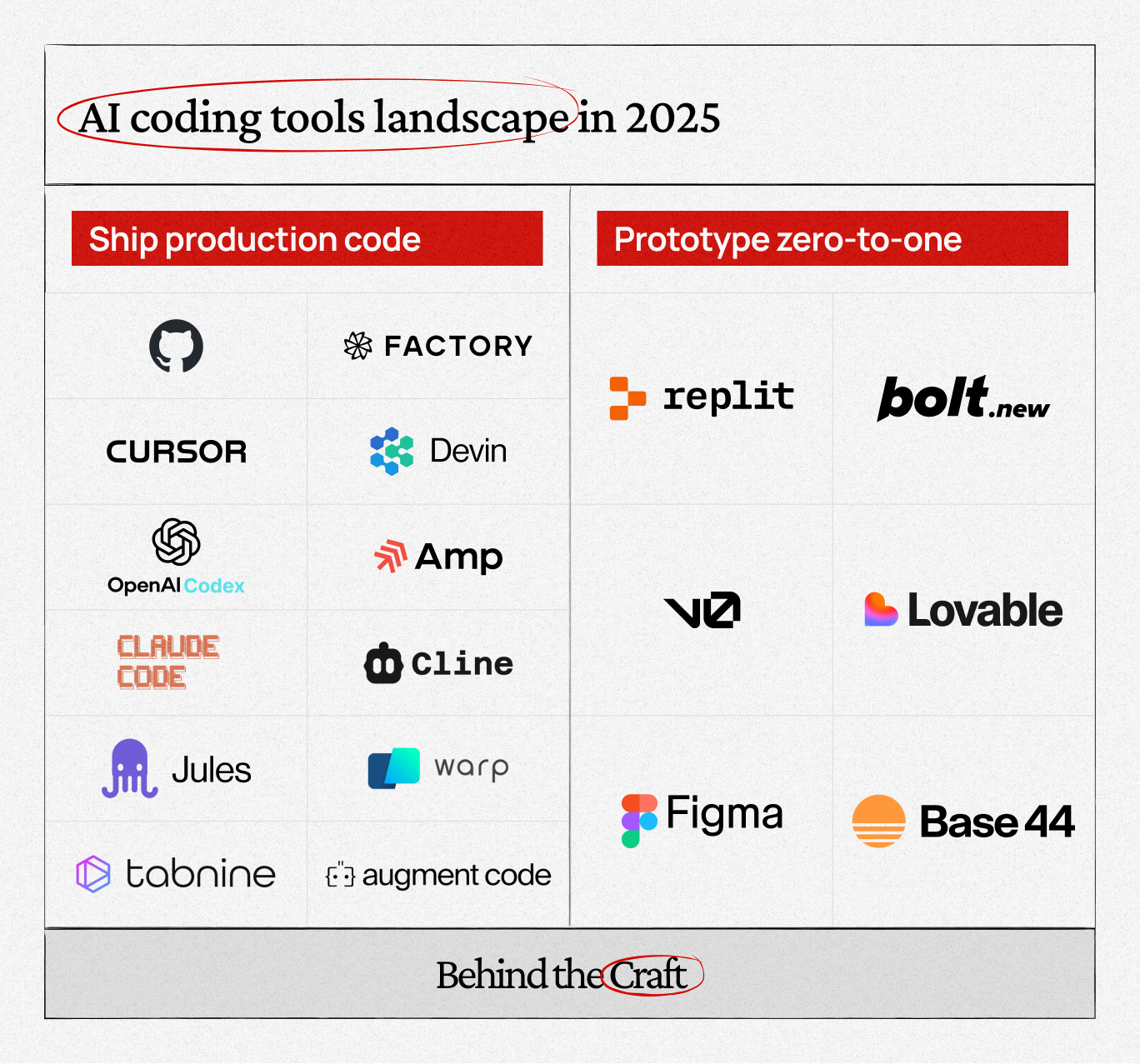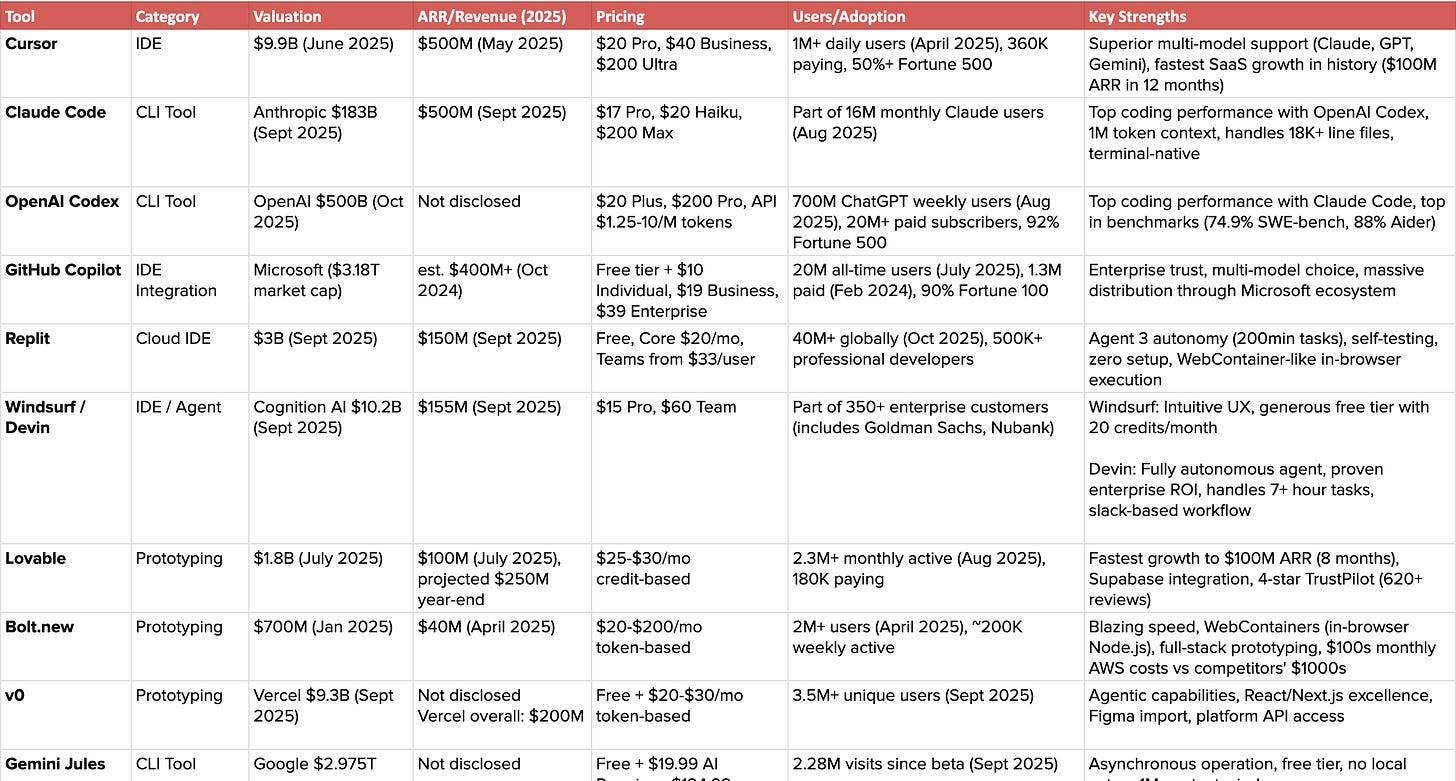Who Will Actually Win the AI Coding Wars?
A deep dive on all 20 major AI coding tools, 5 hot takes based on my conversations with top AI coding founders, and who I think the winners will be
Dear subscribers,
Today, I want to share some real talk about the AI coding market.
There are A LOT of AI coding tools so I want to share what I’m hearing from founders and builders behind the shiny ARR numbers.
Let’s cover what’s happening behind the scenes:
Five hot takes on where this market is headed
A breakdown of all 20 major AI coding tools
My take on who the winners will be
Thanks to Bland for sponsoring today’s newsletter!
Bland builds AI support agents that sound human and run 24/7. Features include:
Custom prompts and guardrails for on-brand conversations.
Integrations with your CRM, scheduler, and existing systems.
Self-hosted infra with 99.99% uptime and zero marginal call costs.
Bland handles millions of interactions daily for companies like Gallup, Samsara, and Snap. Try calling 415-480-0000 or visit the link below to learn more.
5 hot takes on where this market is headed
1. Enterprise adoption is where the money is
As I wrote in my 15 hot takes about AI post, the real money for AI coding is at enterprises where you can deliver clear ROI by helping engineering teams ship faster.
The data backs this up. The two leading AI coding tools both target enterprises — GitHub Copilot has 1M paid subscribers across 90% of the Fortune 100 while Cursor has $500M+ ARR with half the Fortune 500 using it.
Here’s why the other segments might struggle with retention:
Early adopters chase the next shiny thing. The startups and people posting about “multi agent workflows” on Twitter will always switch to the latest tool to gain an edge. That’s not great if you’re looking for long-term retention and revenue.
Small businesses have smaller budgets. I can see SMBs using AI coding tools instead of website builders like Squarespace to create sites with backends and databases. But these incumbents aren’t sitting still (e.g., Wix acquired Base44) and SMB budgets can’t match enterprise deals.
Consumers don’t think vibe coding is a painkiller. I don’t believe normal people wake up thinking “What app should I build today?” They’d much rather play with AI video feeds like Sora, which recently hit #1 in the App Store.
The most valuable customers are engineers, PMs, and designers at enterprises. These people want AI coding tools that work reliably, integrate with existing workflows, and come with enterprise-grade security and support.
2. Enterprises only care about two problems
I think enterprises are only willing to pay for two AI coding use cases:
Help engineers ship production code. This means using AI to refactor code, handle migrations, add features, and fix bugs in existing code bases. Most AI coding tools compete here because it’s the bigger market.
Help non-engineers prototype 0-1. This means helping designers, PMs, marketers, and founders build apps, websites, and internal tools from scratch. Lovable, Bolt, Figma Make, and v0 play here.
Replit is unique in that they target both use cases, though I think their marketing leans heavily toward building 0-1.
3. Helping engineers has clearer ROI than prototyping
With AI coding, the most value comes from solving the boring, high-friction workflows that engineers don’t want to deal with manually.
AI coding is great for migrations, refactors, code reviews, and documentation.
This makes sense when you think about ROI. For example, Factory (a popular AI coding agent) points to 96.1% shorter migration times and 95.8% reduction in on-call resolution times for their customers.
Compare this to prototyping.
Yes, it’s useful for PMs and designers to prototype ideas quickly with AI. But how do you measure ROI? How much faster can you validate an idea with AI versus Figma? And when every prototyping tool generates similar-looking components, where’s the differentiation?
Prototyping is still valuable, but production code has clearer ROI.
4. Cost is often the make or break factor
The reality that I’m hearing from founders and enterprises is that:
Companies are very cost-conscious about AI right now. Claiming that your AI agent can work autonomously for 30 hours will just scare the Finance team.
It’s all too easy for a few power users to burn through thousands of dollars in tokens in a single session. Enterprises want predictable costs and care about compliance and security. Many have implemented hard caps on monthly AI spending per employee.
The tools that figure out transparent, value-based pricing with clear cost controls and compliance will thrive.
5. Distribution often beats a better product
Everyone’s always talking about the latest agentic coding tool or SWE benchmark on Twitter, but enterprise distribution is what matters.
For example, GitHub Copilot is still incredibly popular with 20M users and $2B ARR despite everyone on Twitter obsessing about Cursor, Claude Code, or Codex. When I asked why in my tweet above, the answers were clear:
Copilot is the default for GitHub and VSCode which almost all enterprises use.
Copilot is cheaper than alternatives with predictable caps built in.
A similar dynamic might play out in prototyping. Getting through enterprise procurement is much easier when you’re already an established vendor like Figma.
But there’s a twist I’m seeing play out:
Some tools are getting into enterprises through the back door — individual employees start using a tool without formal approval.
That organic adoption eventually forces IT and security teams to either block it or officially adopt it. This bottom-up adoption can be just as powerful as top-down sales.
A breakdown of all 20 major AI coding tools (October 2025)
I admire every founder building in this space given how brutal the competition is.
So I created a detailed comparison table with valuation, ARR, pricing, users, and key strengths and weaknesses for all 20 top AI coding tools, including:
Cursor, Claude Code, OpenAI Codex, GitHub Copilot, Replit, Windsurf / Devin, Lovable, Bolt, v0, Gemini Jules, Figma Make, Cline, Factory, Amp, Warp, Roo Code, Tabnine, Base 44, Augment Code, and Amazon Kiro
This table answers questions like:
Which tools raised the most money and at what valuation?
Who has real traction versus just hype?
What are the strengths and weaknesses of each?
Below’s the link to this detailed table and I’ve also included my thoughts on who I think the winners will be:






